Driving In Georgia And Armenia – The Road Trip Of A Lifetime!
Doing a road trip through Georgia and Armenia has definitely been one of our travel highlights. As tourism to the Caucasus grows it is only natural that more and more travellers will take the option of self drive trips through this fascinating region of the world. Driving in Georgia and Armenia gives you the freedom to explore areas that would otherwise be unaccessible. Naturally there are challenges that come with doing this however driving in both countries is generally very safe. Driving in both Georgia and Armenia may seem like a crazy idea initially. However with reliable car rental services springing up in Tbilisi and Yerevan it is becoming more and more accessible.Take advantage of it now!
The main thing you need to be aware of the quality of the roads and the occasional speeding driver.
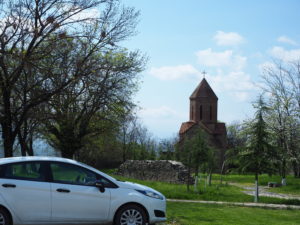
Is it safe?
Driving in Georgia and Armenia can be a little nerve wracking at first, especially driving in Tbilisi and Yerevan. However in both countries the roads are generally quiet outside of the capitals. Generally I found driving here to be quite safe, aside from the occasional driver who pulled out onto the highway without looking (yes, really).
The road quality was the most frustrating aspect of our trip. Driving in both Georgia and Armenia there is a good chance you will encounter some roads that are in pretty horrendous shape. Just take us slow and avoid the potholes and you will be fine.
The main things you need to be aware of the quality of the roads, people don’t use mirrors or indicators that often and they don’t drive particularly slowly.
Do I need need an International Driving Permit (IDP) ?
At the time of writing (April 2018) you did not need an IDP to drive in either Georgia or Armenia. However it is always worth checking for your particular country just to be sure. License’s from most western countries along with China, Japan and South Korea should be fine.
Language issues
You do not need to speak Armenian, Georgian or Russian to be able to drive in either country. Both countries have signs in the national language and English. That being said, knowing some Russian is extremely helpful!
What route did we take?
We started and ended in Tbilisi, spending a 6 of our 18 days in Armenia. Our route was as follows:
Tbilisi to Kazbegi
Kabegi to Telavi
Telavi to Sighnagi
Sighnagi to Rustavi via Davit Gareja
Rustavi to Dilijan
Dilijan to Yerevan
Yerevan to Gyumri
Gyumri to Akhaltsikhe via Vardzia
Akhaltsikhe to Kutaisi
Kutaisi to Tbilisi via Uplistsikhe
Obviously there were numerous day trips and side trips to places close to where we were staying, but this forms the spine of the route we took for our trip.
How do the locals drive?
In a word, fast. When driving in Georgia or Armenia expect to see plenty of hair raising over taking moves on mountain roads as well as on major highways. I definitely did not drive as fast as the locals in either country, and as a result I spent a reasonable amount of time giving way to those had a better knowledge of the roads than myself.
Also bare in mind that people will just pull out onto highways without looking. Therefore at any service station or petrol station, if a car is on the side of the road there is a decent chance they may pull out. As well as this, people will drive next to the highway, some will enter without signalling and some will carry on driving down the hard shoulder.
Effectively you can never be completely sure what drivers in this situation will do. Pull into the left hand or middle lane (if there is one) to pass and then settle back into the right hand lane.
Your best bet is to stick the right unless you are overtaking a rattling piece of old soviet equipment. This will keep you out of the way of the speeding drivers.
How busy are the roads?
Once you get outside of Tbilisi and Yerevan the roads are generally quiet and the chance of encountering heavy traffic is pretty limited. However entering and exiting these two cities can be a rather chastening experience. You will need to keep your wits about you as both cities have complex one way systems and lanes will occasionally disappear.
The one exception to the above is the Georgian Military Highway to Kazbegi. The number of HGVs that can go through the pass each day is limited and this road is a major trade route for goods entering and exiting Russia.
This means there is a good chance you will pass a long line of stationary lorries waiting for their turn to cross the pass and carry on to their planned destination. Our guesthouse owner in Kazbegi told us that they will sometimes need to wait up to a week for their chance to cross the pass.
They will only allow one direction of HGVs to cross the pass at any one time. Therefore you may be making your journey behind a cue of huge trucks, or you may be squeezing around hairpin bends with the trucks pushing you to the very edge of the road. If you are going against the direction of the trucks then you should be mindful of cars over taking the trucks one by one.
Again, take it slow and keep to the right hand side and you should be absolutely fine.
Road Quality
The road quality in both countries ranges from fully paved multi lane highways though to dirt tracks that would make a 4×4 feel at home. Driving in Georgia and Armenia requires you to be constantly on the look out for potholes.In Armenia they will spray paint squares around the pot holes to make them easier to see. Below is a rough road report on the roads we took at the time of writing.
Tbilisi – Stepantsminda (Kazbegi)
The road condition is good all the way to Kazbegi, however do watch out for potholes and be aware that you may have huge convoys of trucks going in your direction or the opposite way on the mountain passes.
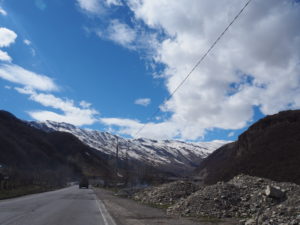
Stepantsminda (Kazbegi) – Telavi
Do not take the turn off at Chinti, this will take you on a windy dirt track with horrendous roads for about 30-40km. There are parts of this road that if negotiated incorrectly could do serious damage to your vehicle. Safe to say it took us a good couple of hours to get through this section. Instead head almost all the way back to Tbilisi, heading east at Mtskheta. It is a longer route in terms of distance, but the roads will be better so it is likely to be far quicker than the route we took.
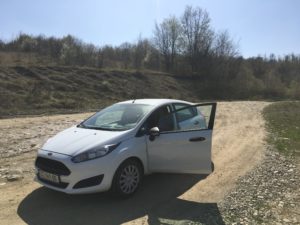
Telavi and surrounding monasteries to Sighnagi
No issues here. All of the major sights around Telavi are accessible with good roads. Do be on the lookout for occasional potholes on entry and exit to Telavi.
Sighnagi to Davit Gareja
From Sighnagi you will initially take the Kakheti highway which is excellent. However just before the town of Sagarejo you will make a left hand turn and head south. From here the road begins to disintegrate dramatically. Parts of the road here are truly horrendous and require extremely careful driving. From a few kilometres after Sagarejo though to Davit Gareja it is a mixture of dirt tracks and bumpy, rock roads.
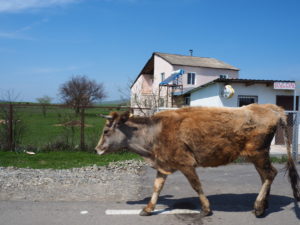
Davit Gareja to Rustavi
The worst roads we experienced on our trip. Coming from Davit Gareja you will retrace your steps east until you reach a t-junction. Straight will take you to Rustavi and a right hand turn will take you back towards Sagarejo. The “road” here mainly consists of tyre marks on the grasslands. Once again this road has the potential to do serious damage to you vehicle. There are steep slopes, deep potholes and lots of mud. Safe to say you should proceed down this road with caution.
This problem is exacerbated by the fact that there is no mobile phone reception. Once you pass the army base (yes really) the road circles onto an actual paved road. We had no issues passing the army base although we did see a bullet riddled “live firing zone” sign. We passed numerous soldiers doing training and had no issues. I think they were just surprised to see two very confused looking tourists. The paved road from the army base to Rustavi, although heavily potholed, is a vast improvement on the previous roads. Plan very carefully how you wish to get to and from Davit Gareja.
Rustavi (Georgia) – Dilijan (Armenia)
From Rustavi you have two choices to get to the border. Loop back round toward Tbilisi to join the E001/highway 7 or take the more direct route we chose. The direct routes roads are fine, but ignore google maps and maps.me.
From Rustavi head south to the town of Meore Kesalo on E60. From here head west along route 164, although this may not be signposted. You will pass through small towns named Didi Mughanlo and Baidari. Do not turn down any side roads as this will lead you into dirt road territory. Just keep following the road and it will bend north east before joining back up with E001. From here to the Armenian border the roads are paved the entire way.
After crossing the Armenian border follow highway 6 to Haghpat and Sanahin. After the town of Alverdi the road goes from a beautiful paved highway to a rubble ridden dirt track. Prepare for a slow journey and sore bottoms. There were numerous signs along this route saying that the roads are due to be fixed in May 2018, so fingers crossed.
Dilijan – Yerevan (via Sevan)
Aside from the heavily potholed roads out of Dilijan the roads on this route are generally very good. A side note here, potholes here and elsewhere in Armenia are are highlighted with paint, making them much easier to see.
Yerevan- Khor Virap – Norovank
The road for this entire route was excellent. The odd pothole here and there, but other than that, no issues.
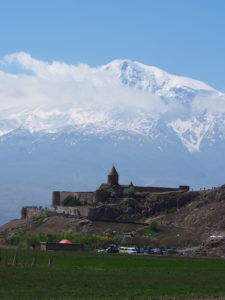
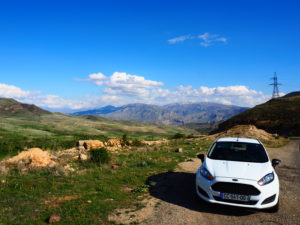
Around Yerevan
Roads around Yerevan were generally excellent. Getting out to Gerghard and Garni is not an issue, although do look out for speed cameras.
Yerevan to Gyumri
We headed to Saghmosavanq and Hovhannavank monasteries before heading on towards Gyumri. The roads up to these two monasteries were excellent. After rejoining highway 1 there were major roadworks at the time of writing.
The only issue here is that you may be stuck behind some slow moving trucks as you cannot overtake, which we found out after overtaking. There is a large police presence in this area so be on your best behaviour. After this, roads to Gyumri via Artik for the Harichavank Monastery were generally very good. The roads around Artik were at times in poor condition though so do watch out for potholes.
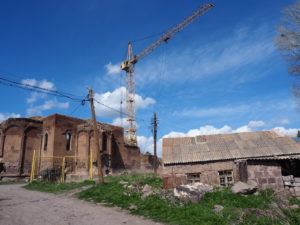
Gyumri (Armenia) to Akhaltsike via Vardzia (Georgia)
From Gyumri to the border the roads are excellent. After crossing the border it is a different story. You will be greeted by a few metres of paved road followed by a few metres of rubble. This carries on untill around Ninotsminda. From here the roads are good. However, when going to Vardzia take highway 11 via Akhalkalaki. The alternative route is taking highway 13 and then dirt roads (which was the route we got from maps.me) After seeing the dirt road we took the longer, although far quicker route along route 11 to Vardzia. From Vardzia to Akhaltsike the road is excellent.
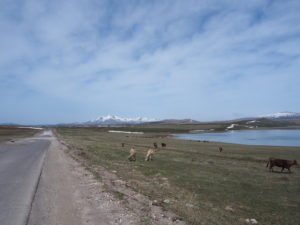
Akhaltsike to Kutaisi
Take the longer route along highway 8 changing turning onto highway 1 at Khashuri. The alternative is a long dirt road track through the Borojomi National Park. Which according to a French couple we met who were driving through the region, was particularly bad.
Kutaisi to Tbilisi
Paved roads all the way, including roads to Uplistsikhe.
Driving in Tbilisi and Yeveran
Tbilisi and Yerevan deserve their own special mentions. Both cities are very busy and the roads are chaotic, they are definitely the most challenging place to drive in Georgia and Armenia.
Tbilisi
Tbilisi is full of one way streets, narrow roads and crazy main roads. Be aware that google maps and maps.me don’t always have the correct one way roads and turnings listed. As a result pay extra attention to road signs before heading down a very narrow street around Tbilisi’s old town.
Also pay attention to the turnings that can be made in particular lanes as these can change in between traffic lights, roundabouts and cross roads. You may be in the left hand lane thinking you can go straight or left. However from one set of traffic lights to another this can change to a left hand turn only lane.
Yeveran
Yerevan doesn’t have the one way streets as per Tbilisi, but the traffic here is probably more chaotic. You will need to pay extra attention to directional indicators above the lanes as they are not always consistent, i.e. what may be left and straight on, may become a left hand turn only lane at the next intersection. The same issues with google maps and maps.me not always being 100% accurate are also apparent here in Yeveran. At the time of writing there were a number of roadworks going on in Yeveran, which caused issues with google maps and maps.me.
If you are staying in Yeveran, which we were, then it is a better to stay just outside of the centre as parking in the city centre proper is a nightmare. We found numerous places said they had parking, but what they actually meant was street parking which is not always guaranteed and could leave driving round in circles looking for a space when you return.
Google Maps and maps.me
Both of these are extremely helpful when driving in Georgia and Armenia. However neither of these applications take road quality into account. As a result they will give you the shortest route by distance, however more often than not it will involve taking a road of poor quality. Generally speaking a yellow road should always be good quality, whereas a white road is more likely to be of poor quality. However this is not always the case, we experienced a number of white roads that were of good quality, and some yellow roads that were not particularly good.
Also neither of these applications are up to date in terms of new roads and changes in road layouts. This is especially true in Yerevan and Tbilisi.
Who did we rent from?
We used travelcar we found them through another travel blog. After comparing their prices with a number of other competitors they were comfortably cheaper. They represent the three major car brands Alamo, Enterprise and National in Georgia and Armenia. As a result this gave us a great deal of confidence as there are plenty of dodgy rental companies operating in both countries, which naturally we would not recommend. You can pick up and drop off in either Tbilisi or Yerevan however do be aware there is a one way charge. From our experience they are an excellent option if you’re thinking of driving in Georgia and Armenia.
What extras should you get?
If you a crossing the border you MUST get a border crossing certificate. Travelcar allows you to purchase this as an additional extra when you rent with them. During our research we discovered that not all companies did this. We also got a pocket wifi which will only work in the country it’s given to you in. So when you cross the border it will no longer work.
Travelcar also offers 0 excess insurance for around $100 at the time of writing. Naturally this could increase or decrease depending on the model of the car, drivers age and nationality for example. For us this is a no brainer, and after seeing plenty of dented and smashed up cars upon first arriving in Tbilisi it only confirmed our viewpoint.
Car Passport
This is a a credit card sized identification document for your car. You cannot cross the border without it. It is usually located under the sun visor on the drivers side. Make sure you know where it is before you leave as the car passport proves your vehicle is legally registered. If you don’t have it you will not be able to cross the border and it is likely the police will be called as it will suggest the car is stolen or not registered.
Crossing the border
Georgia to Armenia
We crossed at the Sadakhlo border, pretty much a straight shot down from Tbilisi. When you arrive at the border the passenger must walk across the border and the driver drives across. Border security will ask you for the car passport. This is a little credit card sized piece of plastic usually found under the sun visor. When we were first asked for this we had no idea what the border guard was talking about. Eventually through a bit of Russian and a bit more English we finally got it sorted.
On the Armenian side your car will be checked and they may wish to see inside your luggage. Again, the passenger must walk across the border while the driver drives. One thing that is important to note here, after driving across the border the driver must got back and register, even though you already have a stamp in your passport. Take all of the paperwork given to you by the rental car agency. The border guards will then give you a document with a green stamp. You need to take this document to buy Armenian insurance.
This insurance is mandatory. At the time of writing it cost 17,000 dram for 10 days, which is the minimum insurance period. The guys behind the desk will stamp this green form and you then need to present this stamped document to formerly enter Armenian territory. Make sure you keep this document in a safe place as you will need it when you leave the country.
Armenia to Georgia
We crossed at the border between Bayra on the Armenian side and Zhdanovkani on the Georgian side. This border crossing is pretty desolate. Far quieter than the border crossing we’d used to enter Armenia. On the Armenian side the passenger will need to enter the building and walk through and the driver will drive though. It is likely the border guards will want to check your luggage.
You will need to present the car passport, your own passport and Armenia insurance documents that you got from entering the country. You will then be given an exit stamp in your passport. Proceed to the exit where your passports, yours and the cars will be checked again.
Entering Georgia is very easy. Same as before, the driver drives though and the passenger walks through the adjacent building. The border guards may confirm with you if you have a passenger. It seems your car passport is registered to the driver and passengers. Once they’ve checked your documents you are into Georgia. We did not need to purchase insurance as we were driving with a Georgian plate.
Insurance
Since we rented our car in Georgia we did not need to buy insurance when we crossed back into Georgia from Armenia. If you are renting in Armenia then check with your rental agency about insurance requirements in Georgia. We saw numerous truckers buying insurance after crossing the border close to Kazbegi.
Filling Up
All of the petrol stations we visited in Georgia and Armenia were serviced. Therefore when you pull up someone will come and fill up your car. Do not expect them to speak English. The likelihood is that you will need regular unleaded. Fortunately regular is a cognate in Russian and thusly sounds almost identical. The attendants will ask you how much you want in Russian, Georgian or Armenian. As I spoke a little Russian they would always ask us in Russian. Sadly my Russian didn’t extend to “full” initially but they either understood my English or my sign language.
Roundabouts
These can be a rather confusing experience in both countries. Ordinarily when entering a roundabout you will need to give way to on coming traffic. In the case of Georgia and Armenia, the traffic to your left. However a large number of roundabouts require the opposite. The traffic on the roundabout is expected to give way to the traffic entering the roundabout. This is shown by which triangles on the roundabout just before each entrance.
Use of horns and lights
Overtaking drivers will beep if they are passing to warn you that they are coming. Occasionally people will flash their lights behind you to show they are intent on passing. However to add to the confusing nature of driving here people will also beep and flash their lights to say thanks.
Police
We had no issues with police in Georgia, there is a reasonable police presence around most towns although not on open highways. Armenia was a slightly difference story. We were pulled over for overtaking a lorry, slightly ironic as we had just seen plenty of locals do it, but it is what it is.
The policeman spoke English and was very polite. He was not aggressive or threatening at all. He told us what the fine was for and explained that he didn’t want to have to fine us but that it was the law. They asked me if I would like to pay the fine now or at a bank. I said now and requested documentation of payment. At this point he decided not give me a fine and wished me well on my journey. I’m not sure if he was looking for a bribe, he most certainly did not give me that impression. The best advice I can give is to be polite and remain calm.
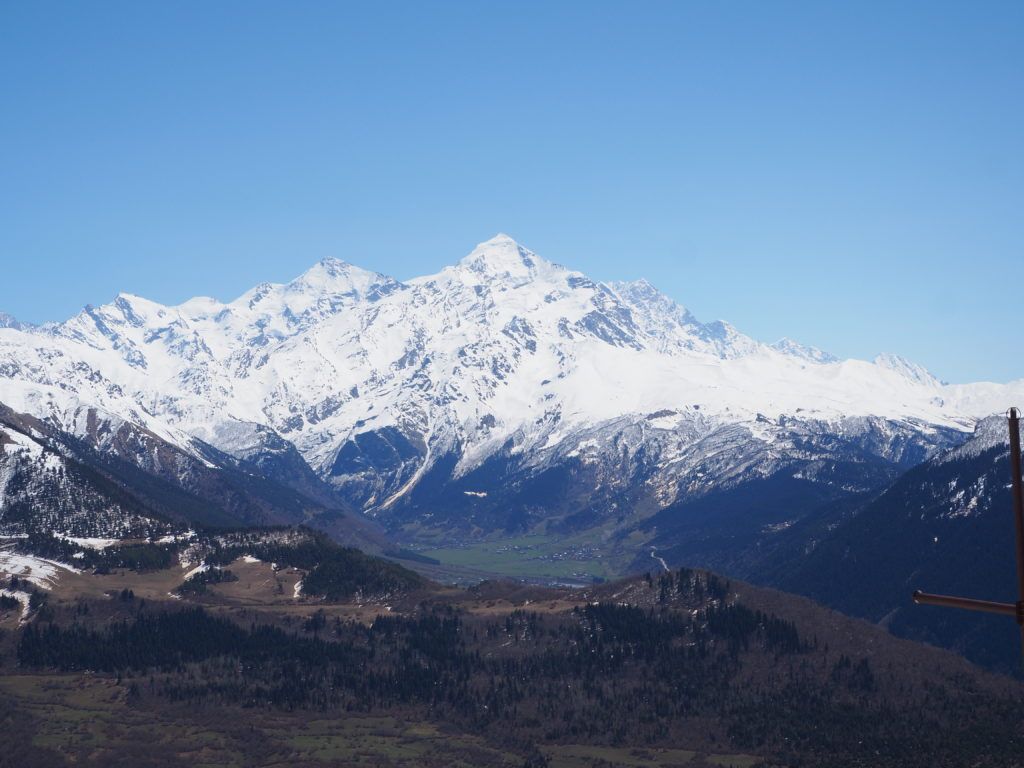
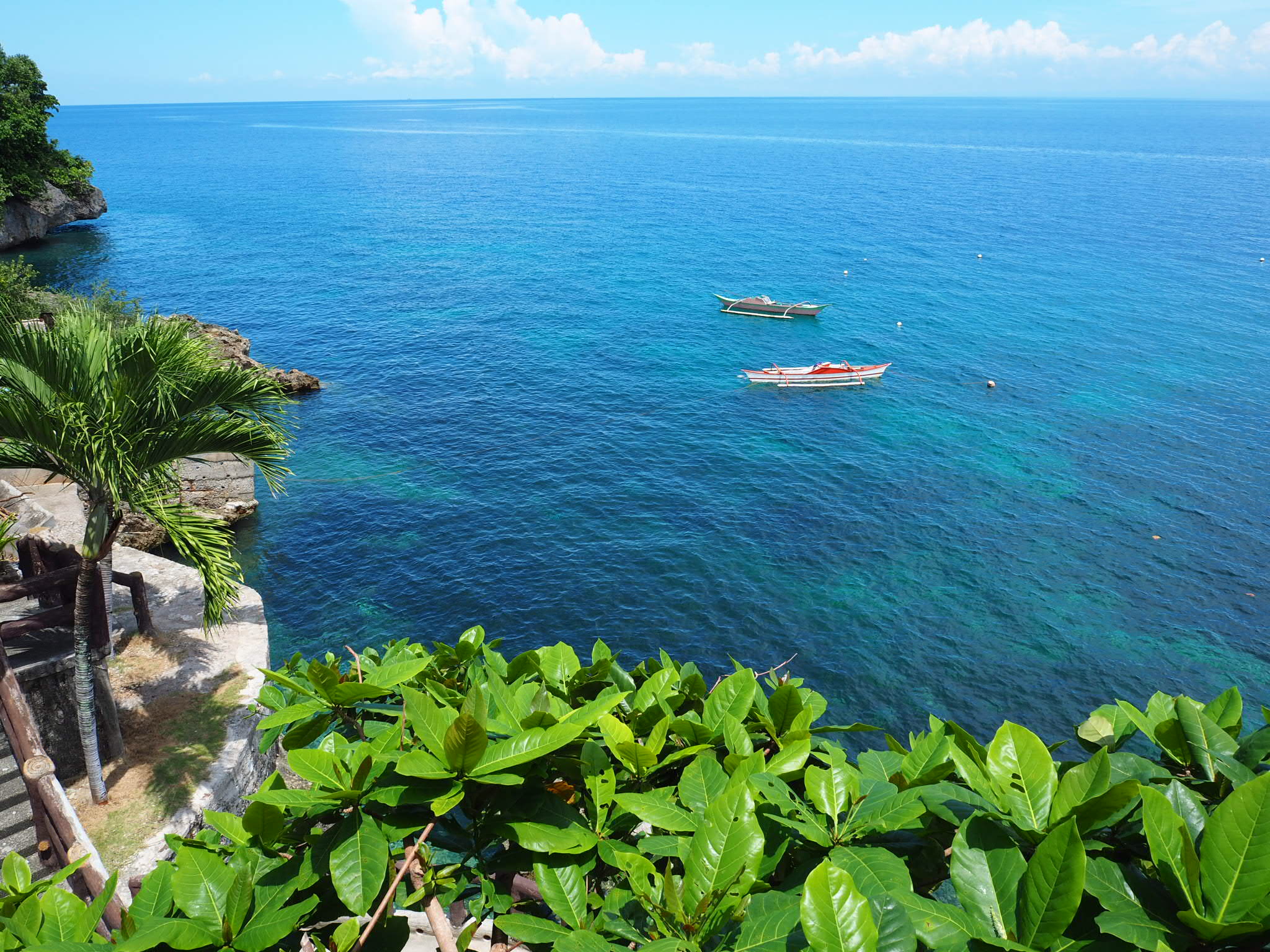
5 Comments
Hello Richard and Miranda,
Thanks a lot for this post! It was super useful as my wife and I planned a roadtrip from Tbilisi to Yerevan and back now on February 2020. I wanted to come back to your post and thank you but also to post some updated information or insights we learned along the way for future travelers and reference 🙂
First off, do not get a basic economy car to do this drive! 🙂 I naively rented a Ford Fiesta that barely made it properly through the entire journey, but it was very hard for the poor thing to hold up! I’d advise going for someone larger and ideally 4×4. Not because we are such outdoors drivers but because with so many dirt and gravel roads, there’s a lot of piece of mind of driving a vehicle that can actually manage it.
Second, not sure how ideal is to drive during the winter! We did this drive on February when most tourists are in the Caucasus area during the summer. The winter is harsh, specially around Vanadzor which is quite high! So there were miles and miles of road that I had to drive through snow (mostly plowed, but not always). Reconsider proper snow tires and chains if you know you’re going high up.
Third. Do not pay attention to Google Maps. I’ve learned that the best road is M16/H26 which Google Maps will not suggest because it theoretically touches some small bits of Azeri territory (on the far east side of Armenia). This road, despite of the UK travel advisory which you will find online, is perfectly fine and there’s virtually no problem or danger going through it. After reading reviews and reviews on Tripadvisor and other sources, I decided to do this road on the way back from Yerevan to Tbilisi and it saved us around 4 hours. The road we took was Yerevan-Sevan-Dilijan-Ijevan-Noyemberyan-Sadakhlo. It is a beautiful drive and as said, we didn’t have any problem and military presence was minimal.
Fourth, on the way to Yerevan we crossed the border also in Sadakhlo. 7 kms into Armenia there’s a fork. Going left will take you to M16, and going right will take you in the middle of Armenia through Alaverdi. This was probably the worst drive of my entire life: Endless roads of dirt, gravel and massive delays. At some point I honestly though the poor Ford Fiesta was going to break or the tires flat, etc. This was for many miles. Apparently the Armenian government is doing plenty of roadwork there to enhance the communication between Russia and Europe towards the south, but it’s nowhere near done, so I doubt they’ll be done any time soon in 2020.
We decided not to adventure into the west of the Caucasus out of fear of our car breaking down, but we heard great things of the landscapes over there. However, I was also conscious of the advice against the roads around Brava on the Georgian side. Overall quite an experience that could’ve been better with a bit more knowledge 🙂
Thanks Richard and Miranda again, your post helped me and my wife make better choices and better decisions at the end 🙂
David.
Hi David,
Thanks for the kind words. We crossed at the same point from Georgia to Armenia and can certainly attest to the conditions of that road not being the best. When we were there they were still working on it however it seems they have not made a huge amount of progress. Google maps can be extremely hit or miss! We ended up taking on all kinds of dirt roads. We did our trip in April so, we had avoided the worst of winter, however, there will certainly be some parts where I’m sure the conditions can be treacherous.
We did our trip in a ford fiesta, and aside from dirt/poor quality roads, we were fine, however, we did not have winter to deal with so the increased mud would certainly have played a factor for sure!
Glad this article helped, and thanks for sharing your experience with other travelers!
Thank you for this article. I have one question. I love riding a scooter and always do when I’m traveling. I also did it in Georgia when I visited the country in 2018 and 2020. Some of your routes you describe I also drove with a scooter. But some not. Thats why I want to ask if you can remember if all of them are good for scooter rides or if you remember trips between cities with very bad road conditions that it is maybe not good for going there with a motorbike.
Thanks for sharing your expirience!
Hi Tanja,
Apologies for the late reply here. You will be fine with a motorbike, but a scooter is certainly risky I would say. The main challenges we had were around David Gareja, and driving to Dilijan from the Armenian border. The latter was under construction when we were there, but progress is slow so I imagine it could be hit and miss. Hope that helps!
Thanks for your answer, that was helpful!